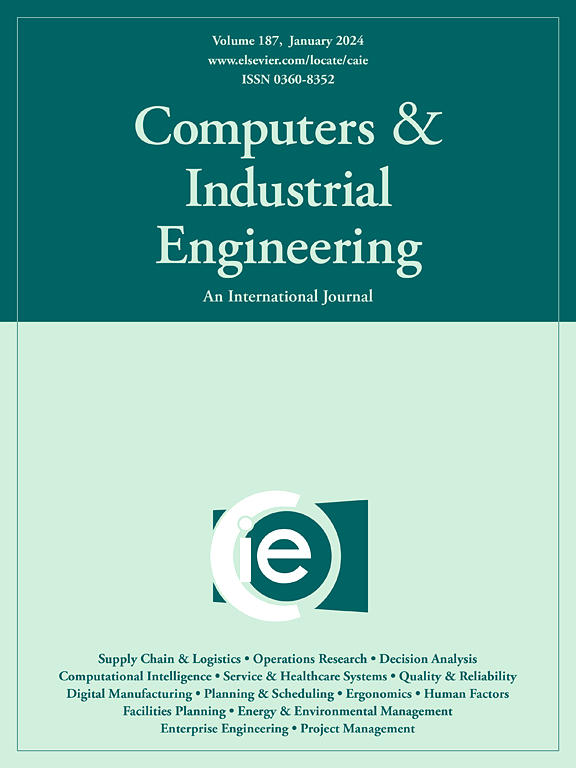增强机床预测性维护:一种集成改进深度自编码器和图注意网络的双模型方法
IF 6.7
1区 工程技术
Q1 COMPUTER SCIENCE, INTERDISCIPLINARY APPLICATIONS
引用次数: 0
摘要
随着机床数量和复杂程度的不断增加,各种机床故障层出不穷,固有制造过程的稳定性受到威胁。一方面,高维数据难以有效地用于准确预测故障发生的时间。另一方面,在预测性维护阶段,即使对故障时间有一个粗略的估计,维护人员也很难快速找到故障的根本原因。其根本原因是在故障预测和维护中缺乏对大量底层知识的相关性的认知和推理。针对这一问题,提出了一种基于深度自编码器和图注意神经网络的双模型驱动预测维护方法,以提高机床的稳定性。首先,基于机床故障数据采集、CNN-BiLSTM-Autoencoder驱动的故障预测模型和图注意网络驱动的维修服务推荐,设计了双模型驱动的预测维修系统架构,具体如下图所示。在获取高维故障数据的基础上,提出了一种基于cnn - bilstm - autoencoder的机床故障预测模型,该模型能够捕捉故障特征之间的内在关系,计算出准确的故障预测结果。基于准确的故障预测结果,提出了一种基于改进的图注意网络与神经张量网络相结合的有效维修服务推荐方法,该方法可以捕获故障原因与维修服务之间更复杂的关系。在此基础上,可以推荐符合实际故障维护需求的维护服务。最后,在不同类型机床的加工车间进行了对比实验,验证了该方法在故障预测和维修建议方面优于传统方法。本文章由计算机程序翻译,如有差异,请以英文原文为准。
Enhancing machine tool predictive maintenance: A dual-model approach integrating improved deep autoencoders and graph attention network
Along with the increasing amount and complication of machine tools, various machine faults appear and the stability of the inherent manufacturing process may be threatened. On the one hand, high-dimensional data is difficult to be effectively used to accurately predict the timing of a fault. On the other hand, even with a rough estimate of the fault time, it is difficult for maintenance personnel to quickly find the root cause of the fault during the stage of predictive maintenance. The fundamental reason is the lack of cognition and reasoning about the correlation of a large amount of underlying knowledge in fault prediction and maintenance. To address this issue, a dual-model driven predictive maintenance approach is proposed by using deep autoencoder and graph attention neural network to enhance the stability of machine tools. Firstly, a system architecture of the proposed dual-model driven predictive maintenance is designed with fault data acquisition of machine tools, fault prediction model driven by CNN-BiLSTM-Autoencoder, and Graph Attention Network-driven maintenance service recommendation, which can be illustrated minutely as follows. Based on the acquires high-dimensional fault data, a CNN-BiLSTM-Autoencoder-based fault prediction model is proposed for machine tools, which can capture the underlying relationships among fault features to calculate accurate fault prediction results. Based on the accurate fault prediction result, an effective maintenance service recommendation approach is proposed based on the improved Graph Attention Network combined with Neural Tensor Networks, which can capture more complex relationships among fault causes and maintenance services. Based on this, maintenance services that well match maintenance requirements for actual faults can be recommended. Finally, comparative experiments are conducted within a machining workshop featuring a diversity of machine tools, which confirm that the proposed approach can exceed traditional methods in terms of fault prediction and maintenance recommendation performance.
求助全文
通过发布文献求助,成功后即可免费获取论文全文。
去求助
来源期刊

Computers & Industrial Engineering
工程技术-工程:工业
CiteScore
12.70
自引率
12.70%
发文量
794
审稿时长
10.6 months
期刊介绍:
Computers & Industrial Engineering (CAIE) is dedicated to researchers, educators, and practitioners in industrial engineering and related fields. Pioneering the integration of computers in research, education, and practice, industrial engineering has evolved to make computers and electronic communication integral to its domain. CAIE publishes original contributions focusing on the development of novel computerized methodologies to address industrial engineering problems. It also highlights the applications of these methodologies to issues within the broader industrial engineering and associated communities. The journal actively encourages submissions that push the boundaries of fundamental theories and concepts in industrial engineering techniques.
 求助内容:
求助内容: 应助结果提醒方式:
应助结果提醒方式:


